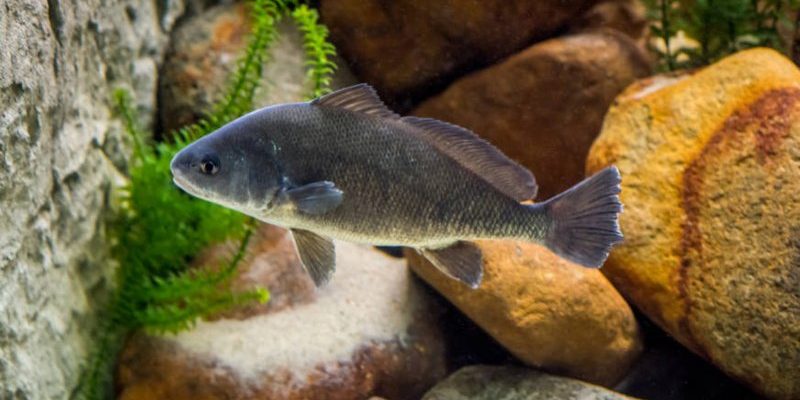
The Freshwater Drum, also known as the Sheepshead, is one of those fascinating fish that often flies under the radar. You might find them lurking in rivers, lakes, or even the brackish waters where rivers meet the sea. Just imagine a fish that not only has a unique appearance but also comes with a rich history and ecological role. It’s a bit like discovering an old book in a library that holds more stories than the cover suggests.
So, what makes the Freshwater Drum so special? Well, for starters, they have a distinct body shape—short and deep, with a face that can seem a bit grumpy at times. But don’t let that fool you; they play a significant role in aquatic ecosystems and can even provide some tasty meals for those who enjoy fishing. Whether you’re a seasoned angler or just curious about these fish, there’s plenty to learn about their habits, habitats, and fascinating features.
Physical Characteristics
First up, let’s dive into the physical characteristics of the Freshwater Drum. These fish can grow quite large, with some individuals reaching up to 30 inches in length. Their bodies are typically a dull grayish color, often accompanied by a shiny belly that can reflect light like a mirror. This surprising beauty is often overlooked, especially when you see them swimming among bolder-colored species.
Their dorsal fin is long and can be a bit spiny, which serves as a defense mechanism against predators. The mouth of the Freshwater Drum is rather unique, situated on the underside of its head, which gives it a rather comical look. This structure allows them to forage on the bottom of lakes and rivers, where they primarily feed on invertebrates and smaller fish. It’s interesting to think of them as underwater bulldozers, scouring the sediment for meals.
Habitat and Distribution
Freshwater Drums are quite versatile when it comes to their habitats. They are primarily found in freshwater environments, such as lakes and rivers, but they can also tolerate brackish waters. This adaptability makes them quite resilient. They are most common in the Mississippi River system and can also be found in the Great Lakes and the coastlines of the United States.
You might be wondering what makes these fish choose their specific spots. They prefer shallow waters with sandy or muddy bottoms where they can easily hunt for food. If you’re ever fishing, look for them around rocky structures, submerged logs, or near vegetation—these are prime spots where they like to hang out. Their habitat preferences reflect their adaptability and give them a strategic advantage in finding food and avoiding predators.
Diet and Feeding Habits
When it comes to food, the Freshwater Drum is not overly picky. Their diet mainly consists of invertebrates like insects and crustaceans, as well as smaller fish. Think of them as nature’s cleanup crew, helping to keep ecosystems balanced by controlling small fish populations. They are also known to forage on the lake or riverbed, using their specialized mouths to dig into the substrate.
What’s fascinating is how they use sound to communicate, especially when it comes to mating and territory claims. They produce a distinct “drumming” sound by contracting their muscles against their swim bladder. This is where they get their name. Imagine being underwater and hearing this thumping rhythm, perhaps as a way of saying, “This is my turf!” It’s a unique trait among fish and adds to their allure.
Reproduction and Lifespan
During spawning season, which typically occurs in late spring to early summer, the Freshwater Drum demonstrates interesting behaviors. Males will create nests in gravel or sandy areas to attract females. After the females lay their eggs, the males fertilize them and guard the nest until they hatch. It’s a bit like a family affair, where dad takes on the responsibility of protecting their future generation.
In terms of lifespan, Freshwater Drums can live quite a long time, with some reaching up to 15 years or more in the wild. This longevity is an interesting aspect of their life cycle and reflects their adaptability in various environments. It’s both comforting and intriguing to think about these fish continuing their lives in ecosystems that might look quite different from one season to the next.
Conservation Status
Currently, the Freshwater Drum is listed as a species of least concern, which means they aren’t in immediate danger of extinction. However, this doesn’t mean we should take their presence for granted. Like many freshwater species, they face threats from pollution, habitat destruction, and climate change. It’s vital we pay attention to their ecosystems, ensuring they remain healthy and balanced.
Efforts to monitor their populations are ongoing, and recreational fishing regulations help keep their numbers stable. It’s always a good idea to engage in responsible fishing practices and consider the health of the waters where we fish. After all, today’s choices can impact the future of these unique fish and their habitats.
Table of Interesting Facts
| Common Name: | Freshwater Drum |
| Scientific Name: | Aplodinotus grunniens |
| Size: | Up to 30 inches |
| Weight: | Up to 50 pounds |
| Diet: | Invertebrates, smaller fish |
| Lifespan: | 15 years or more |
| Habitat: | Freshwater lakes, rivers |
Fishing for Freshwater Drum
For anyone interested in fishing, targeting Freshwater Drum can be a rewarding experience. They are known to put up a good fight, making them a fun catch for anglers. If you’re planning a fishing trip, you’ll want to use bait that appeals to their diet. Worms, minnows, or jigs can work wonders. Just imagine reeling in a sizable Freshwater Drum—what a thrill!
One important tip is to be mindful of the local fishing regulations, as these can vary based on the region and season. Ensuring sustainable fishing practices helps protect this species and their habitat for future generations. Plus, there’s something quite satisfying about following the rules while enjoying the great outdoors. It’s a win-win situation!
Myths and Misconceptions
There are a few myths about Freshwater Drums that might surprise you. One common misconception is that they are a poor choice for eating. While it’s true that they have a unique taste, many anglers swear by their flavor, particularly when cooked properly. They can be prepared in various ways—grilled, baked, or even fried. Think of them as a hidden gem in the culinary world.
Another myth is that they are hard to catch. In reality, they can be quite accessible to anglers who understand their behavior and feeding habits. By choosing the right bait and fishing in the right spots, you might just land yourself a Freshwater Drum that becomes the star of your next dinner party. Who wouldn’t want to impress their friends with a delicious, home-cooked fish dinner?
The Freshwater Drum is a fascinating fish with unique characteristics, ecological importance, and culinary potential. From their intricate communication methods to their resilient nature, everything about them is intriguing. By learning more about these fish, we can appreciate their role in our ecosystems and promote practices that ensure their survival for future generations.
So the next time you’re near a body of freshwater, keep an eye out for these remarkable creatures. Whether you’re fishing, observing, or simply enjoying the beauty of nature, the Freshwater Drum is a wonderful reminder of the vibrant life that thrives beneath the surface.
FAQ
What is the best time of year to catch Freshwater Drum?
The best time to catch Freshwater Drum is typically during the warmer months, especially in late spring and early summer when they are spawning. During this time, they move into shallower waters, making them easier to target. As temperatures rise and the water becomes more inviting for anglers, so does the chance of a successful catch. Early mornings or late evenings can be particularly productive times, as they are often more active then.
Are Freshwater Drum good to eat?
Yes, many people find Freshwater Drum quite tasty! They have a mild flavor that can be enhanced with the right seasoning or cooking method. Some enjoy them grilled, while others prefer frying or baking. Just be sure to cook them properly to eliminate any fishy taste. For those who are adventurous in the kitchen, experimenting with different recipes can lead to some delightful discoveries.
How can I identify a Freshwater Drum?
Identifying a Freshwater Drum can be straightforward if you know what to look for. They have a distinct body shape that is deep and compressed, and their color ranges from a grayish or brownish hue to a more silver appearance. Their dorsal fin is long and often spiny, and their mouth is located underneath their head. To spot them, look for their characteristic round shape and listen for the drumming sounds they make while trying to communicate.
Do Freshwater Drums prefer muddy or rocky bottoms?
Freshwater Drums are quite adaptable and can thrive in various environments. However, they often prefer sandy or muddy bottoms where they can easily forage for food. They are known to hunt among submerged rocks and vegetation as well, especially when looking for small prey. This adaptability helps them thrive in a range of habitats, so whether the bottom is rocky or muddy, they can usually find a way to make it work.
How do Freshwater Drums communicate?
Freshwater Drums communicate primarily through sound, producing a drumming noise by contracting their swim bladder. This sound can be heard underwater and is used for various purposes, including attracting mates and establishing territory. It’s a fascinating aspect of their behavior, allowing them to convey messages to each other even in murky waters. This communication is essential for their reproductive success and social interactions within their population.
What predators do Freshwater Drums have?
Like many fish, Freshwater Drums face threats from various predators. Larger fish species, such as pike or bass, often prey on them, especially when they are younger and more vulnerable. Birds of prey, such as herons and eagles, are also known to hunt them when they venture into shallow waters. It’s a tough life under the surface, but their robust nature helps them navigate these challenges effectively.
Can Freshwater Drum live in saltwater?
While Freshwater Drums are primarily freshwater fish, they can tolerate brackish water—where fresh and saltwater mix. This ability allows them to adapt to varying environmental conditions, but they are not typically found in pure saltwater environments. This versatility helps them survive in different ecosystems, but they thrive best in freshwater systems where their population can flourish.
How do I catch Freshwater Drum?
Catching Freshwater Drum requires a bit of strategy. Using bait like worms, minnows, or jigs can be effective. Look for them in shallow, rocky areas or near structures like submerged logs. Be patient, as they can be cautious. A steady hand and light tackle can make a difference in successfully reeling one in. Remember, they can put up a good fight, making it an engaging experience for anglers.
Are Freshwater Drums territorial?
Yes, Freshwater Drums can exhibit territorial behaviors, especially during the spawning season. Males will often guard their nests and display aggressive behaviors to deter other males from encroaching. This territoriality helps ensure that they can effectively reproduce and protect their young. Their unique drumming sounds often play a role in establishing and maintaining these territories.
What is the impact of pollution on Freshwater Drums?
Pollution can have significant negative effects on Freshwater Drums and their habitats. Contaminants can harm their health, alter their reproductive success, and disrupt their food sources. High levels of nutrients can lead to algal blooms that choke off oxygen in the water, making it difficult for them to thrive. Conservation efforts are essential to keeping waterways clean and ensuring that Freshwater Drums continue to prosper in their natural habitats.

